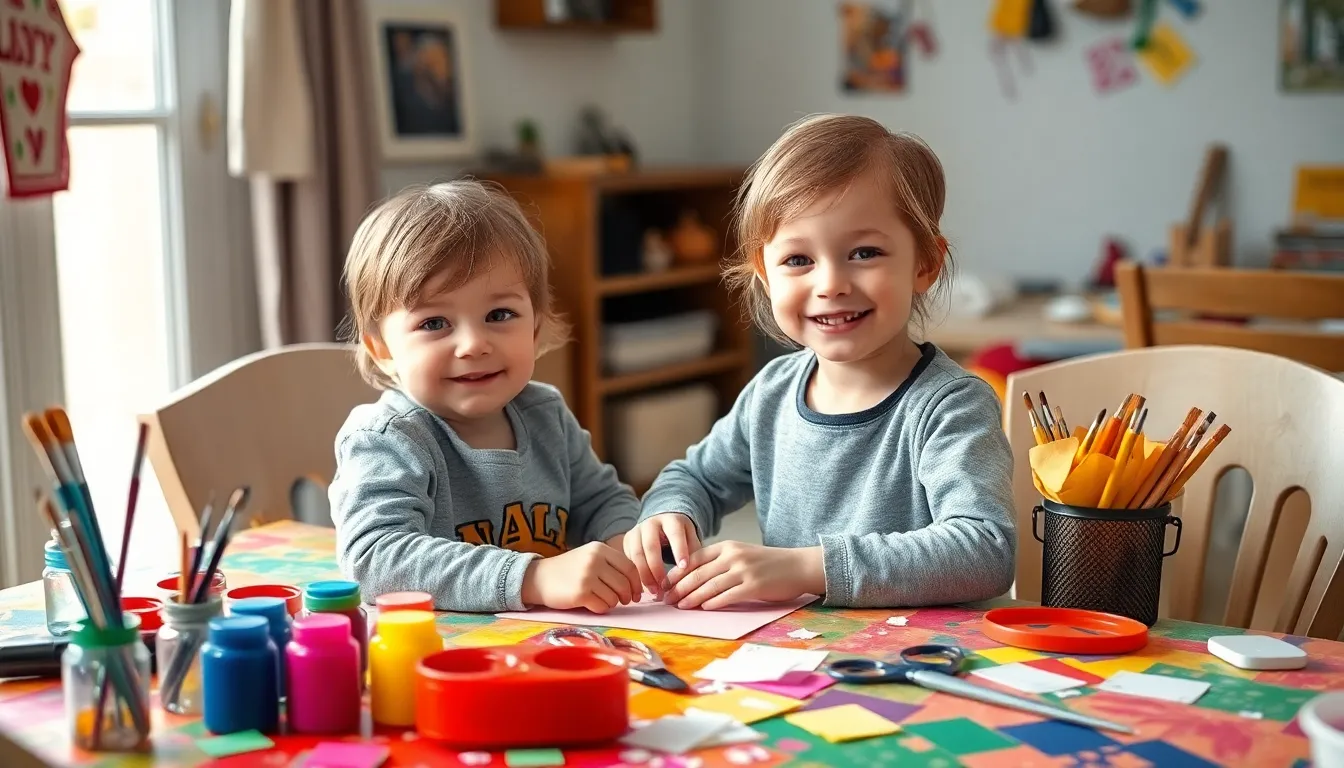Every parent knows that keeping kids entertained can be a full-time job, and let’s face it—sometimes the TV just won’t cut it. Enter DIY projects, the superhero of boredom-busting activities! With a sprinkle of creativity and a dash of enthusiasm, these hands-on adventures not only spark imagination but also unleash a whirlwind of giggles and mess.
Table of Contents
ToggleOverview of DIY Projects for Kids
DIY projects offer a variety of engaging activities for kids. Creative tasks spark imagination and help develop problem-solving skills. Constructing crafts from household items often leads to unique creations. These projects promote fine motor skills and encourage artistic expression.
Kids enjoy hands-on experiences that stimulate their curiosity. Fun activities can include building birdhouses, designing jewelry, or creating homemade slime. Choosing age-appropriate projects ensures safety and enhances enjoyment. Parents should supervise younger children during intricate tasks to prevent accidents.
Moreover, DIY projects can strengthen family bonds. Collaborating on a project fosters teamwork and communication. Families can share responsibilities, allowing each member to contribute to the creative process. Celebrating completed projects gives kids a sense of accomplishment.
Environmentally conscious projects also teach sustainability. Recycling materials for crafts shows the importance of resourcefulness. Kids learn valuable lessons about reusing and reducing waste while engaging their creativity.
Variety abounds in DIY project options. From simple paper crafts to advanced woodworking, countless approaches exist. By exploring different themes, children can discover their interests and passions. Setting aside regular time for these activities provides consistent opportunities for creativity to flourish.
Emphasizing both fun and education, DIY projects remain an effective tool for entertainment. They offer a rewarding alternative to passive screen time, promoting active learning and exploration. This balance of enjoyment and development makes DIY projects a valuable addition to kids’ routines.
Benefits of DIY Projects

DIY projects offer numerous advantages, making them valuable for children’s development and enjoyment. These hands-on activities not only entertain but also promote learning.
Encouraging Creativity
Creativity flourishes through DIY activities. Engaging in projects allows kids to express themselves without limitations. Immediate feedback occurs when they make choices about colors, shapes, and designs. Children learn to innovate as they explore different materials and techniques. Experimentation encourages them to think outside the box, fostering original ideas. A range of activities, from painting to sculpture, sparks their imaginations. Each project presents a new opportunity for self-expression and artistic exploration.
Enhancing Problem-Solving Skills
Problem-solving skills develop naturally through DIY projects. Kids encounter challenges during these activities, which prompts critical thinking. They analyze situations and devise practical solutions. With experience, children gain confidence in their ability to navigate obstacles. Crafting a birdhouse or designing a simple machine requires logical reasoning and planning. Each step in the process enhances their analytical skills. Additionally, collaboration with peers or family members further enriches their learning experience, promoting communication skills in overcoming difficulties.
Popular DIY Projects for Kids
Many engaging DIY projects captivate children’s interest and creativity. Here are some popular categories that foster learning and fun.
Arts and Crafts
Arts and crafts projects allow kids to explore their creativity. One popular activity includes making greeting cards using paper, markers, and stickers. Kids can experiment with color combinations and designs. Another fun option involves creating unique wall art with paint and canvas. This encourages them to express their feelings and ideas visually. Additionally, designing friendship bracelets with beads enhances fine motor skills. Materials for these projects are often readily available at home or nearby stores.
Science Experiments
Science experiments provide hands-on opportunities for learning. Simple experiments, like making a volcano with baking soda and vinegar, teach basic chemical reactions. Kids gain excitement from watching the eruption and witnessing science in action. Another interesting activity involves growing crystals using sugar or salt. This stimulates curiosity and patience as they watch crystals form over time. Lastly, exploring the properties of magnets through various tests engages young minds and encourages scientific inquiry.
Outdoor Projects
Outdoor projects create opportunities for active play and learning. Building a birdhouse offers children a chance to learn about nature and wildlife. Kids can decorate their creations with eco-friendly paint, enhancing both creativity and environmental awareness. Another exciting idea centers around starting a small garden. Planting seeds and caring for them fosters responsibility and patience while also teaching about ecosystems. Additionally, crafting a nature scavenger hunt promotes physical activity and exploration, encouraging kids to engage with their surroundings.
Tips for Successful DIY Projects
Successful DIY projects engage kids while enhancing their creativity and skills. Implementing thoughtful planning ensures a productive experience.
Choosing Age-Appropriate Projects
Selecting age-appropriate projects fosters safety and enjoyment. Younger kids benefit from simpler tasks like coloring, gluing, or basic crafts. Older children can tackle more complex projects such as building models or woodworking. Research shows that age-appropriate activities boost confidence and skill development. Finding projects that match a child’s interests sparks enthusiasm and encourages participation. Parents should also consider the materials needed, ensuring they’re suitable for each age group. Encouraging kids to lead on activities aligned with their abilities nurtures independence.
Ensuring Safety During Activities
Safety remains a top priority for DIY projects. Always supervise children during activities that involve sharp tools or small parts. Utilizing non-toxic materials minimizes health risks. Setting clear boundaries helps kids understand the do’s and don’ts while crafting. Reinforcing safety practices like wearing protective gear, such as goggles or gloves, proves essential in certain situations. Creating a designated workspace keeps everyone focused and reduces the risk of accidents. Additionally, discussing safety rules before starting reinforces awareness and responsibility. Establishing a clean-up routine minimizes hazards and teaches best practices for future projects.
Resources for DIY Inspiration
Explore a variety of online platforms dedicated to DIY projects for kids. Websites like Pinterest offer endless ideas with detailed instructions for various age groups. Blogs focusing on family activities often provide innovative project suggestions, complete with photos and step-by-step guides.
Books remain a fantastic resource, especially those specifically targeting children’s crafts. Titles such as “The Big Book of Kids’ Crafts” showcase diverse projects that spark creativity and cater to different skill levels. Libraries frequently host craft events, allowing children to engage in hands-on learning while connecting with peers.
Social media groups centered around DIY projects provide valuable inspiration and community support. Platforms like Facebook host groups where parents share tips and completed projects. Instagram accounts dedicated to kids’ crafts feature ideas ranging from simple to more advanced endeavors, helping expand creative horizons.
YouTube channels focus on DIY tutorials. Channels like “Art for Kids Hub” offer engaging video content, making it easy for children to follow along. Parents can watch alongside their kids, enhancing the experience through collaboration and shared learning.
Craft stores often host workshops where children can learn new techniques and discover materials. These workshops introduce kids to various artistic tools, fostering confidence and craftsmanship. Additionally, local community centers may offer classes, providing structured environments for kids to explore their creativity.
Utilizing these resources makes it easier to find engaging projects that inspire kids. Each option encourages interaction, creativity, and skill development, enriching their DIY journey.
DIY projects for kids offer an exciting way to ignite creativity and foster learning. These hands-on activities not only entertain but also enhance problem-solving skills and promote collaboration. By engaging in DIY projects, children can explore their imaginations while developing essential life skills.
Parents can find a wealth of resources to inspire meaningful projects that suit their children’s age and interests. With thoughtful planning and supervision, these activities can create lasting memories and strengthen family bonds. Embracing DIY projects is a rewarding way to replace passive screen time with active exploration and creativity.





